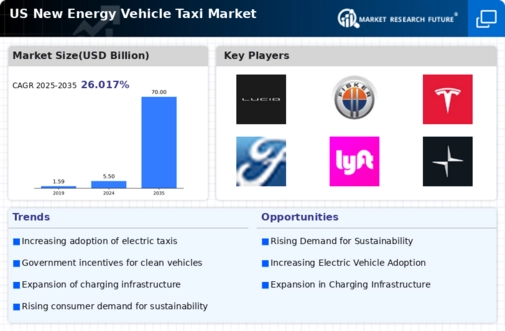The competitive insights of the US New Energy Vehicle Taxi Market reflect a dynamic landscape characterized by rapid advancements in electric vehicle technology and increasing consumer demand for sustainable transportation options. The market is witnessing a significant shift as traditional gasoline-powered taxis gradually give way to new energy vehicles, driven by regulatory pressures, environmental concerns, and a growing awareness of the benefits of electric mobility. This competitive environment sees established automotive manufacturers and newer entrants alike vying for market share by introducing innovative solutions, enhancing service capabilities, and focusing on building sustainable ecosystems.
The interactions among multiple players are shaping the evolution of the taxi service segment, with an emphasis on reducing carbon footprints and enhancing operational efficiency.Lucid Motors has emerged as a notable player in the US New Energy Vehicle Taxi Market, demonstrating an impressive focus on electric vehicle technology and luxury design. The company's commitment to creating high-performance electric vehicles positions it well to cater to the growing demand for premium taxi services in urban areas. With its advanced battery technology, expansive range, and sophisticated automation features, Lucid Motors commands a competitive advantage among consumers seeking seamless and upscale transportation experiences.
Its strong brand reputation, bolstered by innovative marketing strategies and collaborations, has further solidified its presence in the market.
The emphasis on sustainability and eco-friendliness resonates with the evolving preferences of taxi users, fostering a growing base of loyal customers who prioritize both performance and energy efficiency.Ford Smart Mobility is actively carving out its niche in the US New Energy Vehicle Taxi Market through strategic initiatives aimed at integrating smart technology with electric vehicle solutions. With a diverse portfolio of electric and hybrid vehicles, the company focuses on offering accessible and efficient transportation solutions tailored to urban environments.
Key products like electric vans and shuttles are designed specifically for ride-hailing and taxi services, underscoring Ford's commitment to serving this burgeoning sector.
Its market presence is further enhanced through partnerships, technology investments, and a commitment to research and development, ensuring it remains a competitive force in the evolving landscape. The acquisition of relevant tech firms and collaborations with ride-sharing platforms bolster Ford's capacity for innovation in service delivery, enabling it to harness data analytics and connectivity to improve user experiences. The company's strategies not only enhance operational efficiencies but also align closely with the shifting consumer demands for sustainable urban mobility solutions across the United States.




















Leave a Comment